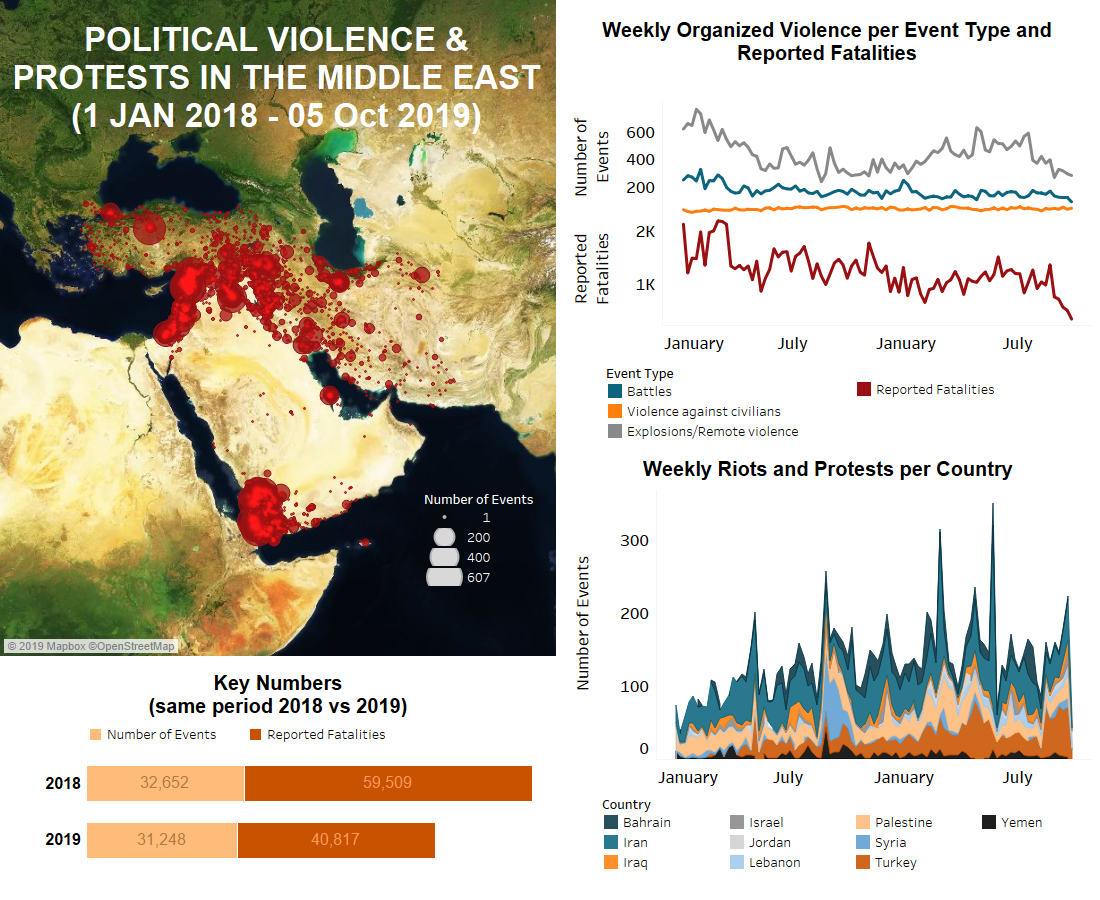Last week, demonstrations over deteriorating economic conditions occurred in several countries across the Middle East. In Iraq, violent demonstrations turned deadly, plunging the country into renewed instability; in Lebanon, demonstrators blocked roads and clashed with security forces while in Jordan the nationwide teachers’ strike turned into the longest public-sector strike in the country’s history. Furthermore, there were signs of possible de-escalation of hostilities in Yemen, whereas in Syria, the conflict dynamics across the country remained largely unchanged.
In Iraq, thousands took part in demonstrations over alleged government corruption, lack of basic services, and growing unemployment. Demonstrations, which were concentrated in Baghdad and in seven predominantly Shiite provinces, started on Tuesday and continued into the weekend despite a four-day curfew and Internet blackout. In several cities, demonstrations turned violent as mostly angry young men threw stones, set fires, and blocked roads while security forces responded with typical riot dispersal methods as well as live fire. Rioters also set fire to political party offices and stormed provincial council buildings. Furthermore, it was reported that unidentified masked men attacked the offices of several television stations in Baghdad. This is not the first time there have been protests over the economic conditions and poor government services. In July 2018, protests in Baghdad and Basra were also met with violence by security forces (ACLED, 20 July 2018). But the deadly demonstrations last week, which have left several dozen dead and thousands injured, were among the largest seen in decades and pose a serious challenge to the government of Prime Minister Adel Abdul Mahdi. A decree containing 17 planned reforms, including land distributions, construction of 100,000 new housing units, and increased welfare stipends for families, was issued by the government in a bid to calm angry demonstrators. The government has also pledged to create new jobs and boost benefits for those without work to fight unemployment, which according to The World Bank, is around 25% among the youth (Telegraph, 06 October 2019). Iraq is the world’s fifth-largest oil producer and exporter, but its economy suffers from the results of decades-long conflict, exacerbated by endemic corruption. Particularly in the oil-rich areas in the south, the frustration with the government seems to be high, as the budget allocated for the region by the central government does not reflect the region’s wealth (Foreign Policy, 9 November 2018). With overall poverty rates estimated at above 20%, citizens’ economic grievances will continue to pose a serious threat to Iraq’s stability in the near future.
Demonstrations over worsening economic conditions were also held in Lebanon. On 29 September, hundreds of people took to the streets in Beirut and several other cities across Lebanon, including Saida, Tripoli, and Baalbek. In Beirut, around 500 demonstrators clashed with riot police after they attempted to break through security barriers and storm their way into the Grand Serail and the nearby Parliament in Downtown Beirut, leading to 5 reported injuries. The recent demonstrations came as the country grapples with an economic and financial crisis that has raised alarms about a possible devaluation of the Lebanese pound due to a dollar shortage in the market, which could lead to significant price hikes. Almost a third of Lebanese live below the poverty line, while the unemployment rate among people under 35 runs at 37% (Asharq Al-Awsat, 2 October 2019). Many people blame the country’s economic problems on the alleged mismanagement and corruption of Lebanese politicians.
Moreover, teachers continued their nationwide strike for the fourth week in Jordan, with two sit-ins reported in Amman and Ajlun, disrupting school for more than 1.5 million students. The country’s longest public sector strike came to an end at the end of the week as the government agreed to raise teachers’ salaries between 35% to 60%. The government now faces the prospect of similar pay demands by other public sector employees, which could derail its efforts to implement fiscal reforms aimed at reducing $40 billion in public debt (VOA, 05 October 2019).
In Yemen, clashes between Houthi fighters and pro-Hadi troops continued in Ad Dali and Hajjah governorates, and in the outskirts of Hodeidah, but an overall decrease in violence could be observed across the country. The Houthis announced the release of hundreds of prisoners of war, including three Saudi nationals, and there were no reports of attacks carried out on Saudi territory this week. Saudi Arabia conducted fewer airstrikes against Houthis forces, and welcomed their ceasefire offer. According to Saudi sources, the Kingdom is considering some form of ceasefire to try to de-escalate the conflict (Reuters, 04 October 2019). Some suggest that US President Trump’s refusal to order a military response to the attacks on two Saudi oil facilities on 14 September has prompted Saudi Arabia to seek alternative solutions, including taking steps towards indirect talks with Iran to defuse tensions (NY Times, 04 October 2019).
Finally, in Syria, there was no major change in the conflict dynamics during the past week. Yet in the meantime, following the United States’ announcement that it was withdrawing its troops from the region, a long-threatened military operation in north Syria against Kurdish forces by Turkey appears to be imminent (Al Jazeera, 08 October 2019).
© 2019 Armed Conflict Location & Event Data Project (ACLED). All rights reserved.






